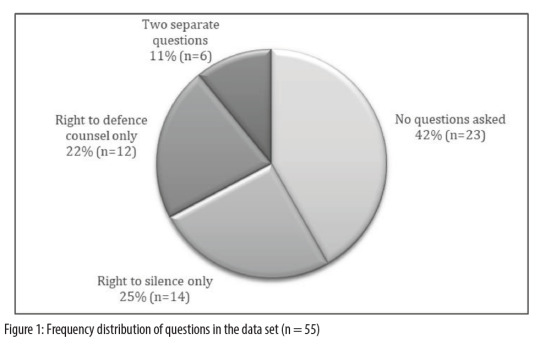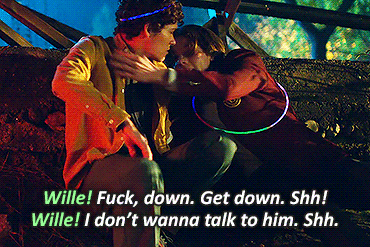#Applied Linguistics
Explore tagged Tumblr posts
Text
Hello everyone,
Remember when I posted about my thesis about Spider-Man: Into the Spider-verse Polish translation?
I have great news!
I finished it!!!!!!
Right now, when writing this post, I am waiting for the train to the city my university is in to finally give the binded versions (one in hard cover and one in soft cover) to my promoter. I am so happy!
I will defend my thesis soon, I am so excited for that!
And, after defence (or maybe even before) I will talk to my promoter about the issue of the article based on my thesis (he told me before, that there will be a competition for thesises, so I will ask him about it again).
Again, I am so happy.
Hope to tell you more soon!

#into the spider verse#spiderman#thesis#translation studies#applied linguistics#linguistics#lingblr#polish langblr
3 notes
·
View notes
Text
recently attended a linguistics workshop at a sci-fest. one of the speakers was my friend who taught kids to create chat bots
the golden collection of their search queries:
лингвист кто это [linguist who dis]
лингвини это [linguini is...]
привет привет я посылаю тебе привет скачать бесплатно mp3 [hi hi I send u hi download free mp3]
что тут делать [wat do here]
если хочешь танцевать танцуй танцуй ну а если хочешь петь то пой со мной [If u wanna dance dance dance or if u wanna sing sing with me]
I’m in love with kids’ problem-solving skills :)

2 notes
·
View notes
Text

Frequency of questions regarding certain legal rights in Norwegian police interviews.
Diepeveen, A., Svennevig, J. & Urbanik, P. (2021). Suspects’ opportunities to claim their legal rights in police investigative interviews. International Journal of Speech, Language and The Law, 28(2), 171-200. https://doi.org/10.1558/ijsll.20349
#applied linguistics#circle diagram#questions#interrogation#Aafke Diepeveen#Jan Svennevig#Pawel Urbanik#IJSLL
3 notes
·
View notes
Text
Gender Centrism, Distance Travelled and the Discursive Construction of Non-Binary Identity: Binary and Non-Binary Trans Acceptance in Queer-Accepting Campus Social Settings - A Tumblr-Originating Theory Paper
Mallory Minerva 2025 Recommended Chicago author-date citation: Mallory Minerva. 2025. Gender Centrism, Distance Travelled and the Discursive Construction of Non-Binary Identity: Binary and Non-Binary Trans Acceptance in Queer-Accepting Campus Social Settings - A Tumblr-Originating Theory Paper. Tumblr. In text: (Mallory 2025)
Positionality Statement
I am a binary trans woman on HRT. I am strongly opposed to transmedicalism, but more saliently I am resoundingly supportive of non-binary people and their right to craft and assert their own narratives. I wish for all trans people to have our own narratives and analysis of ourselves canonized, as the general understanding, especially in academia, of us is not created by or for us. However, the experiential aspects of narrativizing one's own non-binary identity is foreign to me as I am not non-binary. The time I was non-binary for a week before my egg cracked does not count. I also will recognize the fact that I write about binaryness and non-binaryness, as well as cisness and transness, as binary oppositions, which is a colonial imposition that I have internalized.
Introduction
I am at a university where a lot of people have two sets of pronouns, and frankly is very queer. A relatively low percentage of students (meaning, not the overwhelming majority but probably still more than two thirds) are fully cis, so there is a big culture here of non-binary acceptance since so many people, especially in some departments, are at least slightly non-binary. This means that there is a curious situation of non-binary acceptance outpacing binary trans acceptance.
This variance in acceptance is mostly evidenced through language, such as pervasiveness of they/them pronouns being used, such that non-binary people have an easier time being they/them'd than binary trans people have being she/her'd or he/him'd, receiving the "coward's they" (the covert misgendering of binary trans people using they/them pronouns) instead. There are other areas of evidence found through other disciplines such as communication studies and non-linguistic communication, or literally just asking people their opinions (Zimman & Brown, 2024) I am however approaching this from the standpoint of applied linguistics and discourse analysis to figure out the structure of people's theory of gender. My methods therefor are highly informal; drawing from observations I have made and theorizing about them.
Background
Historically non-binary acceptance has been behind binary trans acceptance. This is because while all trans people are a challenge to cisnormativity, binary trans people at least can be related to within the hegemony of the binary, while non-binary people have to carve out completely alternative narratives to cisgenderism. In a social setting where cisgenderism is not explicitly upheld, and is upheld only and inconsistently through implicit bias, there is a context where people do not try to die on the hill of cisnormativity, but still cisnormativity is often done. In particular, this is a social context where many students discover their own non-binaryness, and that is a context that is not fully ready for a complete undoing of cisgenderism.
Another factor that has aided binary trans acceptance is transmedicalism, which itself is a fairly hegemonic narrative due to being invented by influential cis sexologists (you know the ones). When trans people are also transsexual and pursue a normalizing transition rather than a queer transition, cisnormativity is appealed to. The decline of normalizing transition goals indicates a decline of not only transmedicalism but the cisnormativity and cis-male epistemological arrogance that spawned it. Non-binary people and especially gender-fluid people fail to fit this so much that they are still regularly left out of academic and especially psychological peer reviewed literature about medical transition and gender dysphoria. The idea that a trans person wouldn't want to pretend to be cis is alien to transmedicalists.
Now for my hypothesis. In many social settings such as relatively queer campuses, non-binary acceptance has flipped the script and outpaced binary trans acceptance. Instead of having to carve out twice as much theory contrary to cisgenderism in order to gain acceptance, a discursive construction of gender continuum has emerged, likely cisgender in origin, which seems to aid non-binary people specifically in acceptance. I believe this can be analyzed through discourse analysis and applied linguistics, which is beyond the scope of an essay that originated as an impulsive tumblr post. However I will explain why I think this emerged, and it does come from changes in how non-binary identity is discursively constructed within academic and campus culture.
Gender Centrism?
With the increased prevalence and visibility of non-binary people, which itself is not so much a natural progression but more hard-fought through activism and resilience by non-binary people, there is the need for binary people to confront and narrativize their unavoidable presence. Among non-binary people themselves, there is also the need to narrativize and analyze their own existence, relative to both binary cis people and binary trans people. Because of the need for non-binary people to carve out narrativization in the face of binary hegemony, this has in fact occurred in a variety of ways. While for many the narrativization is that non-binary people, as implied by the term non-binary, are in fact not binary, as in existing outside of it, a seemingly very common discursive construction of non-binary identity among binary people is actually the opposite.
Just as the binary itself is hegemonic, the hegemonic and normative way of understanding non-binary identity within social contexts of non-binary acceptance is to place non-binary people, not outside of the binary, but instead right in the middle of it. The content of this construction in its simplest form is that non-binary people are gender centrists. For example, AFAB non-binary people are seen as moving away from womanhood and towards manhood, but incompletely, landing somewhere in the middle of a spectrum. For AMAB non-binary people this applies analogously. The binary is upheld for anyone with a gender; non-binary people with non-fluid genders are more centrally located in the spectrum than their binary counterparts, and gender-fluid people move around in the spectrum. Binary people, cis or not, are on extreme ends. Agender people perhaps are the ones truly able to escape the binary in this discursive construction. Notably however, a key difference between this model and a totally cisnormative narrative is that the gender binary is a continuum or spectrum rather than a binary opposition. Additionally, it is decoupled from sex. When cis people conveying their allyship say that gender is a spectrum, they are likely providing evidence of their internalization or construction of this narrative.
I will not comment on the validity of this discursive construction (hereafter "gender centrism") as an accurate analysis of non-binary identity; I will leave non-binary people to this task. However I will point out that, empirically speaking, this does seem to be a real discursive construction that has developed in social settings with high non-binary acceptance, and it is likely the case that this discursive construction is most common with queer and allied cis people, possibly common with binary trans people, and probably uncommon but still occasional with non-binary people.
Transmedicalism and "Distance Travelled"
To understand how this explains the greater acceptance of non-binary people compared to binary trans people in social settings where this narrative occurs, it is necessary to understand the role of transmedicalism and transsexuality in it. First however there is another key detail of the gender centrism narrative. As the etymology of the morphemes trans and cis imply, transness is about moving to the other side of something, where cisness is about not doing that. Therefor trans people are thought to have moved our positions from a cis starting point to some other destination. With a continuum of gender that non-binary people are in the middle of, it follows that binary trans people have done the most movement, crossing from one extreme to another, where non-binary people have covered a lesser distance. What it means to cover distance relative to a cis starting point is effected by a few factors. Some clearer factors are pronouns, incidence of name-change, changes to stylized acts (Butler, 1988) and gendered technology usage, and so on; the more extreme the change, the less cis one is and the more ground is covered. In short, degree of transness is measured as distance travelled, and when non-binary people are seen as gender centrists, there is less distance travelled and so they are less trans.
Less obviously but probably most powerfully is transsexuality. Because the gender centrism narrative is still somewhat cisnormative, naturally it would include undue emphasis on biological sex and its association with gender. This is somewhat understandable in a society that, even for trans people, values the embodiment of one's gender. Even I seek to embody my gender. Whether cisnormativity is so thoroughly imposed that many trans people seek gender embodiment as a goal (implying, probably correctly, that gender dysphoria has colonialism as a distal determinant) or that the etiology of transness is rooted in the seeking of gendered experiences including embodiment and anatomical experiences, or both, is not necessary here to be decided. It is the case that transsexuality is a common trans phenomenon, and correlates much more with binary trans people than non-binary people, such that HRT and other medical interventions are culturally ubiquitous binary trans symbols.
In a narrative where binary trans people are seen as literally more trans than non-binary trans people, due to a perceived greater distance travelled, and in a co-occurrence of transmedicalist vestiges where transsexuality symbolizes binary transness, medical transition becomes evidence of degree of transness. Changing one's gender embodiment is not quite the same as changing one's gender identity, and is rooted in cisnormativity (as all transmedicalism is). However the symbolization of medical transition gives evidence of distance travelled, and so transsexual trans people of any degree are thought to be more trans than trans people disinterested in medical transition. In fact, transsexuality is likely assumed to be a pre-requisite for a high enough degree of distance travelled necessary to no longer be a gender centrist and fully wrap around the horseshoe of gender.
Discussion
The explanation for how a gender centrism narrative, especially in the context of hegemonic transmedicalism which co-occurs with it, determines a greater acceptance for non-binary people compared to binary trans people, is that if non-binary people are analyzed as having a lower degree of transness, due to being narrativized as having less distance travelled relative to a cis starting point, both due to how non-binary identity is narrativized and how medical interventionism relative to gender is narrativized, then binary trans people are more trans and also that non-binary people are more cis. The greater degree of cisness that non-binary people can be narrativized with is evidenced by notions of AFAB non-binary people being "the girl ones" and other transphobic ideas. In a social context that is even just a little bit cisnormative, acceptance will correspond to cisness. Therefor, if non-binary people are seen as more cis than binary trans people such as in a gender-centrism narrative, they will have more acceptance.
The flip-side is that in situations where non-binary people are increasingly normalized via an assumed milder degree of transness, binary trans people may comparatively struggle with acceptance, or at least perceive a lesser degree of acceptance, compared to non-binary peers, while non-binary people may feel that their gender is invalidated due to being seen as more cis than they actually are. This makes analyzing the utility of the gender-centrism narrative complicated. Positive utility is identifiable. It probably is not of net detriment to binary trans acceptance and has coincided with increased trans acceptance all around since it does imagine a theory of gender that isn't just bioessentialist. Meanwhile it has seemingly helped or at least correlated with a rapid increase in non-binary acceptance, and can be found in social situations where singular they/them pronouns are remarkably common.
On the other hand this situation probably leads people to imagine non-binary identity as more cis than it actually is, which can manifest in treating non-binary people in ways that could either invalidate their genders through microaggressions, or at least fail to properly validate non-binary people. Alongside this as a negative consequence is binary trans people being seen as more extreme in our divergence from gender norms, slowing our acceptance, or even leading binary trans people to actually feel more trans than non-binary people as a product of bitterness, thus buying into the gender-centrism narrative. If a consequence is greater non-binary acceptance and widespread use of the singular they, there is also objectively the phenomenon of they/them being used so pervasively that the "coward's they" becomes socially acceptable, leading to more subtle forms of misgendering for binary trans people that are easy to get away with using plausible deniability and overcorrective language ideology.
In genealogizing the emergence of the gender-centrism narrative, actual Foucauldian Genealogical Analysis is beyond the scope of this tumblr post, but it is worth also recognizing that in the social settings where it has developed, non-binary people do seem to make up most trans people present. While there is a discursive analysis to be done for why there is sometimes greater non-binary acceptance than binary trans acceptance, it is also likely that non-binary people being more common forces acceptance to be created, and cis people uncomfortable with their own transphobia use the gender-centrism narrative to moderate their own acceptance, accepting non-binary people by rationalizing how they aren't as trans as transsexuals. Demographic shift in gender relative to covert and subconscious transphobia may be the historical explanation.
It is also possible that the gender-centrism narrative came first, still as cis creation to understand non-binary people as a then-edge-case, and this led prospective enbies to rationalize their own change of gender as less extreme and thus less daunting from an acceptability standpoint, in which case I feel very empathetic. I was non-binary before I was a trans woman because I felt less daunted since I felt I was travelling less distance. Even I may have internalized this narrative as an egg.
Conclusion
I will point back to my positionality statement and implore non-binary people to discuss and review my ideas, because as a binary trans person I cannot be fully confident in my analysis of non-binary identity, and I have too much imposer syndrome to fully stand by my discourse analysis, despite usually being the smartest person in the room when it comes to discourse analysis. I especially would like to recommend non-binary authors to engage in reflective writing, famously a "truly feminist" genre (Connolly, 2018), as a subversive academic modality for exploring how non-binary identity is discursively constructed in academic culture generally.
References
It's a lot easier to write a research paper in under two hours when you tell yourself that citations are colonizer bullshit!
Butler, Judith. "Performative Acts and Gender Constitution: An Essay in Phenomenology and Feminist Theory." (1988)
Connolly, Bríd. “Reflective Practice and the Feminist Lens: The Other Side.” (2018).
Zimman, Lal, and Cedar Brown. "Beyond Pronouns 101: Linguistic Advocacy for Trans-Inclusive Language in the College Classroom.", in Anne H. Charity Hudley, Christine Mallinson, and Mary Bucholtz (eds), Inclusion in Linguistics. (2024)
#gender theory#discourse analysis#cultural anthropology#gender studies#transgender studies#trans studies#trans#transgender#non binary#enby#theory#transmedicalism#tagging transmedicalism just to poke the truscum hornets nest#truscums DNI#research paper#applied linguistics#linguistics#sociolinguistics#name reveal I guess#I love ADHD#playing with genre and publishing convention here
0 notes
Text
The Fusion of Applied Linguistics, Religion & Politics | A Close Reading Of The Prayers Delivered Before A Donald Trump Rally
The fusion of applied linguistics, religion and politics raises questions about the nature of faith in contemporary America and the extent to which religious rituals are being co-opted for political purposes...
The extract from McKay Coppins’ observations on prayers offered at Donald Trump’s campaign events presents a complex view of contemporary American religio-political dynamics. By analyzing this text critically, several key themes and implications can be discerned. Firstly, Coppins’ description of the prayers as a “strange, revealing religious text” underscores the peculiar blend of the sacred and…

View On WordPress
0 notes
Text
my godddd how do i do research without interaction without another humans no i dont want to do interviews no i dont want to do field observation i just want to read silly lit texts and make silly lit assumptions with some background justification god give me strength
#linguistics#research#applied linguistics#my education has to remain as solitaire as possible#i do not want to engage in human interaction with this one#is TOO MUCH#is tiresome#i want NEED this to be quick and easy#i know it wont#but a girl can dream
0 notes
Text
I don't know how it is in Taiwanese Sign Language, but in American Sign Language, signs are distinguished by handshape, location, and movement, so when Zi Xiang did the sign for FLY, he had the correct handshape and movement.

But it was the wrong location.

And he has been shown to make the location error several times.




Therefore, I don't think he signed LANGUAGE

Handshape and movement are the same, but he did it closer to his lower face, like his chin.

While Shao Peng did it above his mouth.

Therefore, I think Zi Xiang actually signed something about being with Shao Peng rather than LANGUAGE (communicating with him), and that's why Shao Peng paused.

But maybe it's nothing, and I shall enjoy this sign in the meantime.

#see your love#see you love the series#taiwanese sign language#I'm always fascinated by signed languages#a whole degree in sign language linguistics#all so I can apply it to queer shows#as God intended!
188 notes
·
View notes
Text
Fanfic resource/reference: sharing my notes on Swedish nicknames
I've had the privilege of being taught about Swedish nicknames by some knowledgeable Swedes on here, and I've also tried to research them on my own (e.g. this article in Språkvård has been a great resource). I've got a bunch of notes based on the info I've gathered - they are messy, but I figured I'd share them here for any other YR fic writers who find them useful (inspired by @dreamyelectronicmusic asking about nicknames yesterday)!

Some rules and examples:
- Virtually all Swedish nicknames are bisyllabic with emphasis on the first syllable to flow easily with the spoken language!
- Some very typical standard formats:
Girls’ nicknames most typically end in -a, -(a)n or -i: Cecilia > Cilla or Cissi, Charlotta/e > Lotta or Lotti, Therese > Tessan, Louise > Lussan or Lojsan
The most typical format for guys' nicknames consists of the first syllable, a double consonant and -e: Wilhelm > Wille, Simon > Simme, Mikael > Micke, Charles > Tjalle
Fredrik > Fredde or Freddy, Fredrika > Freddi; Freddie can be either but is often assumed female (cf. Maddie)
Alexander > Alex (pronounced a-lex or al-lex); Vincent > Vince is possible (pronounced vin-se)
- Not every name has an "established" or standard nickname
Particularly applicable to new and international names, as well as names that already have a feel and pattern similar to nicknames: Sara, Rosh, Stella, Felice, Henry
Sometimes nicknames based on a more commonly Swedish variant of the name may be used (e.g. Felice and Henry could be something like Flisan and Hempa based on Felicia and Henrik, but this isn't standard)
- Nicknames can be built from the base name by various methods:
From the start: Katarina > Kattis, Carolina > Carro, Ibrahim > Ibbe, Klas > Klabbe, Alexander > Alex, Beatrice > Bea
From the end: Karolina > Lina, Kristina > Tina or Stina
From the middle: Elisabet > Lisa
Cut & paste: Margareta > Meta, Urban > Ubbe, Felicia > Fia, Flisan, Flisi
Adding a middle consonant: Bo > Bosse
Doubling of first letter or syllable: Lennart > Lelle, Fredrika > Fifi
Doubling of middle consonant: Ingrid or Anna > Ninni, Kristina > Nina
- The form of the nickname is simple, preferably with only one (single or double) consonant sound between the vowels:
If the base name contains a consonant group, one of the consonants is removed: Albert > Abbe, Margareta > Maggan, Viktor > Vicke, Marcus > Mackan
Strong consonants (p, t, k, b, d, g, s) are retained over weaker ones (r, l, m, n): Nils > Nisse, exception: Walter > Walle
If the consonants are equally strong, the first one is retained: Viktor > Vicke, Ulrika > Ulla, Mats > Matte
If the nickname does contain a consonant group, the first consonant is a nasal sound (n, m, ŋ): Henrik > Henke or Henka (pronounced heŋke/a)
A consonant (often p) can be added after a nasal sound taken from the base name: Tommy > Tompa, Bengt > Bempa, Henrik > Hempa
The whole consonant group is pronounced in the same part of the mouth and the second sound is always toneless (never b, d, g)
- The first syllable and other weighted syllables are particularly prominent in nicknames and can lead to different variants:
Birgitta > Bibbi, Biggan or Gittan; Margareta > Maggan, Greta or Meta; Elisabet > Lisa or Bettan; Kristina > Tina, Stina, Kina, Kicki, Nina, Tinni, Tinna…
- Nicknames can also be based on last names, anecdotes etc. instead of a given name, and they may act as class markers:
e.g. Jonny/Sonny/Ronny are working class nicknames
Obscure nicknames and unusual variants are upper class: Smysan (not based on a given name); the real King Carl Gustaf was called Tjabo/Tjabbe in his youth; Queen Kristina would never be Kicki/Tina/Stina but e.g. Tinni/Tinna
Cf. Solsidan episode where Mickan tries to establish "Ybby" for Ebba
Some upper-class people still have normal nicknames (e.g. Wille)
- Many people have no nickname at all; some people may have several; others only have them in specific contexts:
some people introduce themselves by their nickname (Micke), others use their given name but also answer to a nickname among friends (Wille)
some women only use nicknames with their female friends
men may also address each other by their last names (remnant of military style)
people in a group may use nicknames based on last names to distinguish between two people with the same first name (but they don't necessarily use that nickname to address the person!)
- NB. some simple names and nicknames are easy to turn into "baby speak" or playground taunt versions (doubling with p or b):
Annapanna, Ollepolle, Walleballe, Soffiboffi etc.
Parents may be mindful of these when naming or nicknaming their child
--
- Added note on pronunciation: a written double consonant in Swedish denotes a doubly articulated sound:
E.g. Tina is pronounced with a long i and short n, Tinna with a short i and long n (English approximation: tee-na vs. tin-na, emphasis on the first syllable)
---
I realise these rules and examples may not be particularly easy to follow - they aren't for me either! But I figured they might be of interest anyway.
As always, additions and corrections are very, very welcome!
#young royals#young royals meta#nicknames in swedish#fic resources#fanfic resource#fic writing#linguistics#tumblr refuses to apply the shrink function consistently but i'm going to use it anyway
50 notes
·
View notes
Text
emo Nico x scene Will Solace...
#pjo#riordanverse#nico di angelo#will solace#solangelo#i need them to be cringe (affectionate) teenagers okay#give me Will with a hardcore homestuck phase and streaks in his hair dyed with kool-aid and striped armsocks#date night is Will teaching Nico how to make kandi bracelets#if youve been here awhile you may know i am a scene Jason believer and the same concepts apply here#listen i just think. emphasizing Nico being emo and giving him a scene boyfriend#its very important though that only certain riordanverse chars fit the vibe to be scene kids#like i dont think Percy would be as much as i want him to be#its antithetical to his character (internalized ableism/bad self-loathing/keeps his head down)#Will and Jason on the other hand would use XD unironically and have a total ball making sparkledog fursonas#Alex Fierro. DEFINITE scene kid. Magnus is already just kind of a little emo. Sadie is a definite yes. Carter. maybe.#i think he'd be adverse at first but kinda get into it casually yknow. he'd dig kandi bracelets at least.#probably get really into linguistic breakdown of xD rAnDoM speech just for fun#Walt no but he could. like. i think he'd be open to trying it. but its not his default state.#Zia. doesnt have the energy but i kinda wanna see it regardless. i think itd be fun for her but on her own she'd lean more goth#Leo? maybe. depends. he's more into doing stuff ironically. Piper. yes. but specifically as an f-you to conventional fashion#Reyna no. Frank maybe. Hazel yes. Thalia maybe. Annabeth hmm. maybe#i think thats all the main casts. Alabaster? YES and i wanna see it.#anyways thank you for coming to my emo x scene ted talk and character evaluations in the tags
160 notes
·
View notes
Text
my grampa said i should work as an interpreter or translator even though im essentially a monoglot he was just impressed i can more or less read german dutch spanish portuguese & italian without studying any of them
#actualy i studied spanish in school but only for 1 year when i was liek 18#maype that is impressive actualy i need to apply myself i have linguistic aptitudes
14 notes
·
View notes
Text
The thing about biodiversity is it's something that you can loose a lot of in a few decades, but getting it back takes a couple million years. It's hard or impossible to estimate how much value any given species or ecosystem provides to humans, but the answer is reasonably often "a fair amount". In light of this, even if you only care about the biosphere for the value it provides to humans, an excess of caution is probably warranted with regard to things that damage it.
106 notes
·
View notes
Text
Hello everyone,
as I am quite impatient, I already started writing the article based on my thesis. It is a quite good way of revising for defence😁 By the way, it will take place on second July, at 4 PM. My promoter even asked us if we will be keen to have a coffee together after it (which is nice)
Can you give me some tips how to retranslate properly? I still don't have the idea how I will do it, as I am focusing right now on summarising the theory from my thesis in the article.
#into the spider verse#spiderman#thesis#translation studies#applied linguistics#linguistics#lingblr#polish langblr#questions#ask
0 notes
Text
ex: leggings → jeggings, shorts → jorts
#linguistics posting#heads up if you can think of other items of clothing this applies to commonly‚ do share#existenceunrelateds#poll#polls
15 notes
·
View notes
Text
Controversial opinion about the ace community!
I think we should say it like AY-EE-GO-sexual instead of just AY-GO-sexual :>
A-ego just feels more right since it’s A = No and Ego = Self. No involvement of the Self
Ay-go is those waffles
#chatterbun#asexual#ace#acespec#aspec#this applies to aegoromantic too btw#I just like the way it sounds better lol sounds more linguistically right
45 notes
·
View notes
Text
rules: tag 10 people you want to know more about (or not)
thank you for tagging me @almayver 🫶
last song: since it's not in english, have a translation of a line or two
"i will warm and nurture love / so it grows inside me like a tree / so the tips of my fingers are covered in it / so it's brimming in me, infinite"
last film: don't remember the last time i watched a movie 😭
last book: still reading 'firekeeper's daughter' by angeline boulley and 'smoke' by turgenev (i always read two different things at once, usually to not let either of my main languages atrophy)
last tv show: leap day!
sweet/spicy/savoury: spicy
relationship status: single and alone 😔✋
last thing googled: bmw 630i (no comment)
currently looking forward to: LOL2025 tomorrow 🙂↕️
current obsession: my sims
i tag @chezlalune @akkpipitphattana @winnysatang @peempeeranat @bluebirdflynn7 (no pressure obviously 🤏)
#archer yearns to apply his degree somewhere jjgkdfjglkfdjgkf#(<- linguistics and translation studies)#archer speaks#Spotify
9 notes
·
View notes
Text
Translingual Practices: Playfulness and Precariousness (Cambridge Approaches to Language Contact)
Source: Cambridge University Press Edited by Sender Dovchin, Curtin University, Perth, Rhonda Oliver, Curtin University, Perth, Li Wei, Institute of Education, University of London Bringing together work from a team of international scholars, this groundbreaking book explores how language users employ translingualism playfully, while, at the same time, negotiating precarious situations, such as…

View On WordPress
#Applied Linguistics#codeswitching#Li Wei#linguistic diversity#linguistics#multicultural#research#Rhonda Oliver#Sender Dovchin#sociolinguistics#translanguaging#Translingual English#Translingual Practices
2 notes
·
View notes